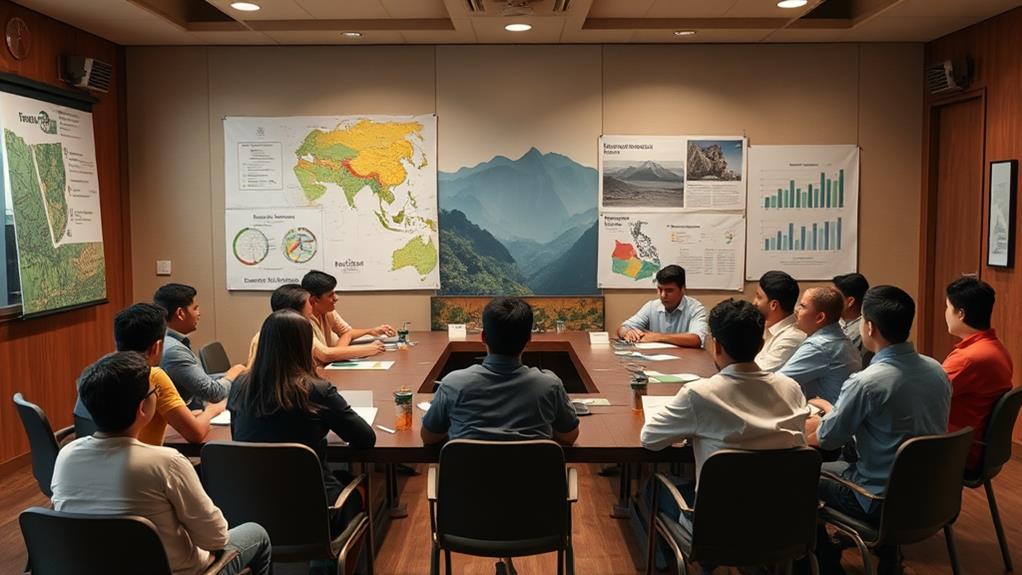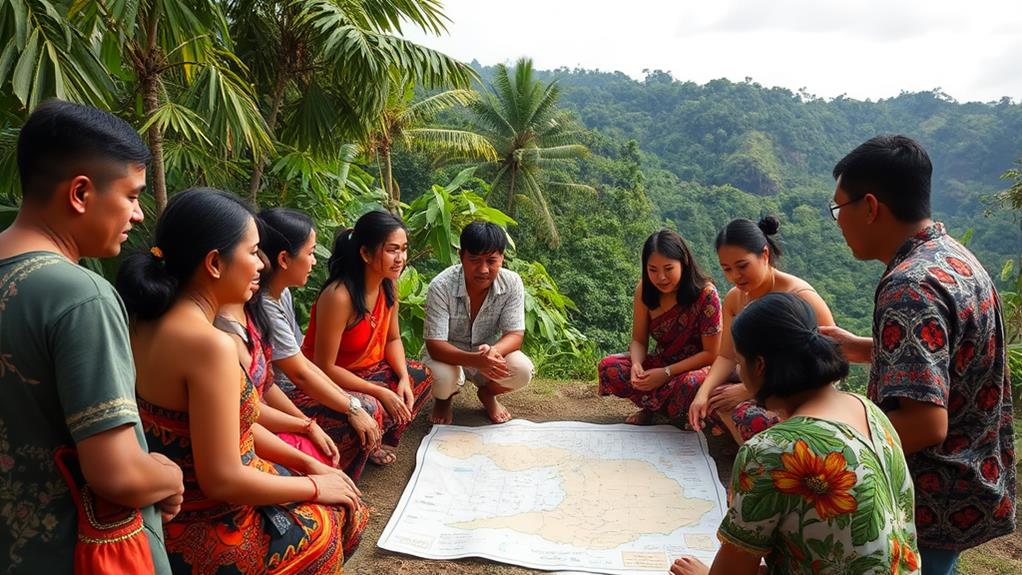Stakeholder engagement is essential for managing resources in the Philippines. It directly addresses important issues such as deforestation and water scarcity. Involving local communities in decision-making helps create a sense of responsibility for natural resources. For example, when communities are included in forest management, they often take better care of the land, leading to successful reforestation projects.
Additionally, including different perspectives in discussions improves decision-making. It helps ensure that everyone has a fair chance to be heard, promoting social equity and transparency.
Case studies show that when local communities work together with the government, they achieve better results. For instance, in some areas, this collaboration has led to improved water security for residents.
In summary, effective stakeholder strategies can have a transformative impact on resource management in the Philippines. Engaging communities not only improves the environment but also strengthens the bonds between people and their natural resources.
Role of Stakeholders in Resource Management

Stakeholders are very important in managing resources, especially in the Philippines. They help address issues like deforestation and water scarcity. The Philippine government encourages local involvement in environmental planning. This helps local communities feel responsible and involved in protecting nature.
Community-based resource management shows how local and indigenous communities can manage resources well. For example, through Integrated Coastal Management, NGOs, government agencies, and local communities collaborate to solve issues related to coastal resources.
Research indicates that when communities engage in sustainable practices, they help reduce conflicts over resource use and support a healthier ecosystem.
Frameworks for Effective Engagement
Effective engagement frameworks are vital for improving teamwork in managing resources. The 5P-10R framework includes Problems, Purpose, Participants, Processes, and Products. This framework helps organize interactions, making it easier to involve stakeholders and make better decisions. For example, using this framework in a water management project can lead to more effective solutions because everyone has a chance to share their input.
Other frameworks, like Arnstein's ladder and Pretty's topology, rank public involvement levels. These models show that engagement strategies should be flexible and fit the specific needs of communities, such as those in the Philippines.
However, research shows that only 13% of the connections between engagement factors are meaningful, indicating that more studies are needed to find effective methods.
To measure how well stakeholder engagement is working, it's essential to have strong monitoring and evaluation systems. These systems collect different viewpoints, helping to create sustainable solutions.
Challenges in Stakeholder Involvement

Involving different groups in resource management can be very challenging. Conflicts often arise because local communities, government agencies, and the private sector have different interests. This makes it hard to engage everyone effectively.
| Challenge | Impact on Stakeholder Engagement | Potential Solutions |
|---|---|---|
| Low Trust | Limits meaningful participation. | Increase transparency and dialogue. |
| Marginalization of Indigenous Peoples | Restricts decision-making voices. | Ensure representation for all groups. |
| Complex Governance Structures | Confuses roles and responsibilities. | Simplify governance frameworks. |
Lack of trust often comes from past issues, making it hard for groups to work together. For example, if communities feel ignored, they may not want to participate. Complex governance can create confusion about who is responsible for what. This can lead to misunderstandings and frustration. Indigenous peoples are often left out, even though they are affected by environmental changes.
To improve participation, capacity-building initiatives are necessary. These programs can help share knowledge and empower local groups. By addressing these challenges, resource management in the Philippines can be more effective, ensuring that all voices are heard and valued.
Case Studies in the Philippines
Collaboration is essential for successful resource management in the Philippines. For example, local farmers and government organizations work together to manage water resources. By using participatory approaches, they've improved irrigation practices, resulting in higher agricultural productivity. This shows that involving various community voices is important for sustainable practices.
Another example is community-based coastal resource management, where local fishermen and indigenous groups work together to protect marine biodiversity. This collaboration meets local needs and encourages environmental care, which is vital for long-term sustainability.
In forestry projects, effective stakeholder engagement has led to a 30% increase in reforestation success rates in different regions. This highlights how teamwork in managing natural resources can create better strategies for water security and climate change resilience.
How Does Media Engagement Impact Stakeholder Engagement in Resource Management in the Philippines?
The role of media in shaping stakeholder engagement in resource management in the Philippines is significant. Media platforms play a crucial part in raising awareness about environmental issues, influencing public opinion, and holding stakeholders accountable. Through effective communication, media engagement can drive positive change and encourage greater participation in sustainable resource management practices.
Benefits of Inclusive Participation

Inclusive participation in stakeholder engagement improves decision-making, especially in managing resources in the Philippines. Involving various voices, like local communities and marginalized groups, leads to better governance of natural resources. This method not only promotes social fairness but also helps in adapting to changes in the environment and community needs.
Here are the main benefits of inclusive participation:
| Benefit | Description |
|---|---|
| Enhanced Decision-Making | Diverse perspectives lead to better outcomes. For example, involving farmers can provide insights on crop management. |
| Improved Project Outcomes | 40% of projects with stakeholder input show real impacts. For instance, a community-based fishing project often leads to better fish stock management. |
| Strengthened Social Equity | Empowering local communities and indigenous peoples is crucial. For example, including indigenous voices helps protect their land rights. |
| Increased Transparency | Open communication builds trust among stakeholders. Regular meetings and updates can keep everyone informed. |
| Greater Collaboration | Aligning different interests helps manage resources better. For instance, a partnership between farmers and environmentalists can lead to sustainable practices. |
Future Directions for Research
Future research in stakeholder engagement for resource management should focus on innovative and interdisciplinary approaches.
It's important to develop effective engagement frameworks specifically for Integrated River Basin Management (IRBM) in the Philippines. This area is currently underexplored, which means there's a significant gap in existing studies that needs to be filled.
Additionally, it's crucial to amplify the voices of marginalized groups, such as local communities and indigenous peoples. By using innovative strategies, we can ensure their representation in stakeholder engagement processes. This will lead to more inclusive participation.
Understanding how socio-cultural contexts affect engagement is important, as factors like governance and culture can greatly influence results.
Questions and Answers
What Are Some of the Benefits of Stakeholder Participation in Natural Resource Management?
Stakeholder participation improves decision-making. When community members share their ideas, decisions reflect their needs and concerns. For example, a local fishing community can provide insights on fish populations, helping to create better fishing regulations.
It promotes sustainable practices through knowledge sharing. People with experience in the area can teach others about conservation methods. For instance, farmers can share techniques for reducing water use, benefiting both crops and local water sources.
Stakeholder participation helps resolve conflicts. Engaging different groups in discussions can lead to solutions that satisfy everyone. For example, if farmers and environmentalists have disputes over land use, a meeting can help them find common ground.
It empowers locals. When community members are involved, they feel more in control of their resources. For instance, local leaders who participate in resource management can better advocate for their community's needs.
Stakeholder participation builds trust. Regular communication between stakeholders creates understanding and cooperation. For example, when local governments involve residents in planning, it strengthens community bonds.
It leads to adaptive management strategies. Involving stakeholders allows for flexibility in management plans. For instance, if a drought occurs, farmers and water managers can quickly adjust water usage plans based on shared data.
What Is the Importance of Stakeholders in Human Resource Management?
Stakeholders are important in human resource management because they help make decisions through clear communication and feedback. Their involvement builds trust among employees and managers. For example, when managers listen to employee concerns, it can prevent conflicts. They also help in evaluating performance by providing different perspectives. This leads to better resource allocation, such as deciding who needs training or support. Overall, stakeholder participation improves relationships within the organization, making it a better place to work.
Why Is Stakeholder Engagement so Important?
Stakeholder engagement is important because it helps build community involvement. For example, when local residents participate in planning a new park, they can share their ideas and preferences. It also improves decision-making by incorporating local knowledge. If experts work with community members, they can create better solutions tailored to specific needs.
Addressing power dynamics is another key point. Engaging stakeholders ensures that everyone's voice is heard, not just those with more resources. This can help prevent conflicts. Additionally, it promotes transparency. When stakeholders are involved, they can see how decisions are made and why.
Finally, stakeholder engagement ensures fairness in resource distribution. For instance, when planning a new public service, input from diverse community members helps allocate resources where they are needed most. Overall, this leads to sustainable practices and better management strategies.
Why Is It Important to Consult With Stakeholders When Preparing a Resource Proposal?
Consulting stakeholders is crucial when preparing a resource proposal. It encourages community involvement and brings in local knowledge. For example, local residents can share information about the area's natural resources, which helps in making better decisions.
This approach builds trust. When stakeholders are included, they feel valued and are more likely to support the project. For instance, involving farmers in water management plans can lead to more effective solutions.
It also promotes sustainable practices. Stakeholders can highlight environmental concerns that may not be obvious to outsiders. An example is when local fishermen point out the impact of pollution on fish populations.
Additionally, consulting stakeholders ensures regulatory compliance. Laws often require input from affected communities. For instance, a proposal for a new park may need input from nearby residents to comply with zoning laws.
Lastly, it aids in conflict resolution. When stakeholders are part of the discussion, it's easier to address and solve potential issues. For example, if a resource proposal affects a local business, discussing it openly can lead to compromises that satisfy both parties.
In summary, involving stakeholders leads to better decision-making, builds trust, promotes sustainability, ensures legal compliance, and helps resolve conflicts.